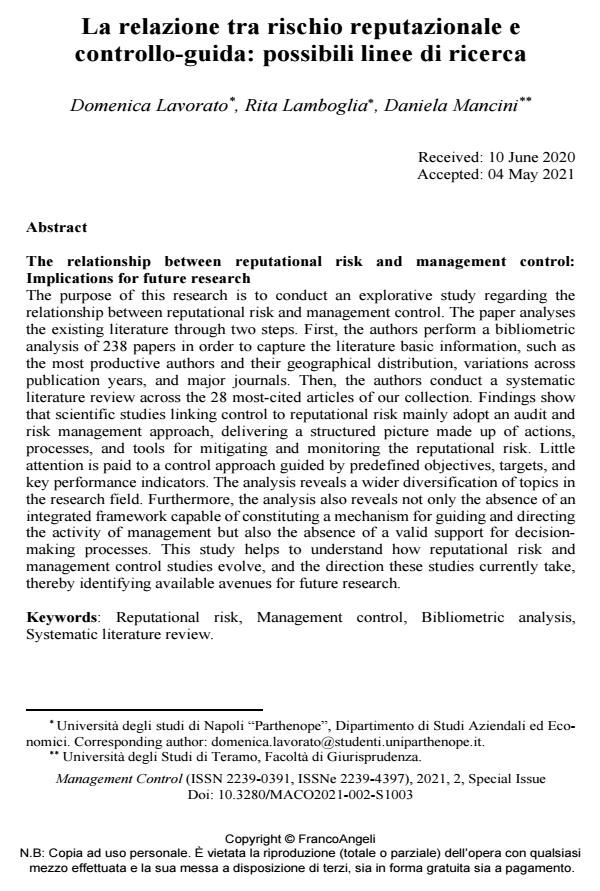La relazione tra rischio reputazionale e controllo-guida: possibili linee di ricerca
Titolo Rivista MANAGEMENT CONTROL
Autori/Curatori Domenica Lavorato, Rita Lamboglia, Daniela Mancini
Anno di pubblicazione 2021 Fascicolo 2021/suppl. 2
Lingua Italiano Numero pagine 26 P. 39-64 Dimensione file 356 KB
DOI 10.3280/MACO2021-002-S1003
Il DOI è il codice a barre della proprietà intellettuale: per saperne di più
clicca qui
Qui sotto puoi vedere in anteprima la prima pagina di questo articolo.
Se questo articolo ti interessa, lo puoi acquistare (e scaricare in formato pdf) seguendo le facili indicazioni per acquistare il download credit. Acquista Download Credits per scaricare questo Articolo in formato PDF

FrancoAngeli è membro della Publishers International Linking Association, Inc (PILA)associazione indipendente e non profit per facilitare (attraverso i servizi tecnologici implementati da CrossRef.org) l’accesso degli studiosi ai contenuti digitali nelle pubblicazioni professionali e scientifiche
The purpose of this research is to conduct an explorative study regarding the relationship between reputational risk and management control. The paper analyses the existing literature through two steps. First, the authors perform a bibliometric analysis of 238 papers in order to capture the literature basic information, such as the most productive authors and their geographical distribution, variations across publication years, and major journals. Then, the authors conduct a systematic literature review across the 28 most-cited articles of our collection. Findings show that scientific studies linking control to reputational risk mainly adopt an audit and risk management approach, delivering a structured picture made up of actions, processes, and tools for mitigating and monitoring the reputational risk. Little attention is paid to a control approach guided by predefined objectives, targets, and key performance indicators. The analysis reveals a wider diversification of topics in the research field. Furthermore, the analysis also reveals not only the absence of an integrated framework capable of constituting a mechanism for guiding and directing the activity of management but also the absence of a valid support for decision-making processes. This study helps to understand how reputational risk and management control studies evolve, and the direction these studies currently take, thereby identifying available avenues for future research.
Parole chiave:Reputational risk, Management control, Bibliometric analysis, Systematic literature review.
- Corporate Reputation as Strategic Intangible Asset Diletta Vito, pp.41 (ISBN:978-3-031-93330-1)
- Management Control System in Smart and Sustainable Firms Domenica Lavorato, pp.59 (ISBN:978-3-031-81435-8)
Domenica Lavorato, Rita Lamboglia, Daniela Mancini, La relazione tra rischio reputazionale e controllo-guida: possibili linee di ricerca in "MANAGEMENT CONTROL" suppl. 2/2021, pp 39-64, DOI: 10.3280/MACO2021-002-S1003